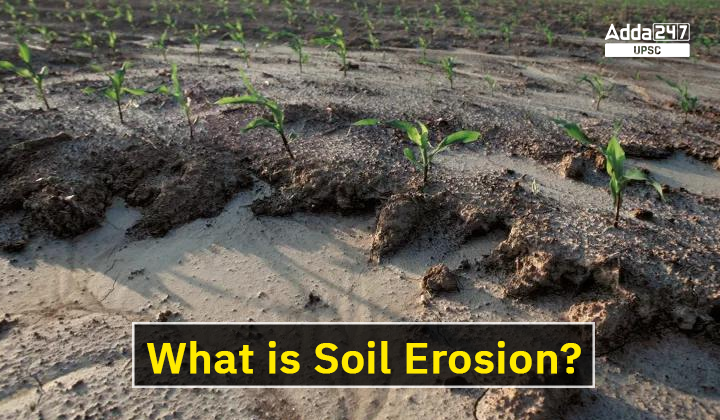Table of Contents
What is Soil Erosion?
Soil erosion is the process by which soil is removed from the land by wind or water. It is a natural process that has been occurring for centuries, but it has been accelerated by human activities such as agriculture, deforestation, and construction. There are two main types of soil erosion: water erosion and wind erosion. Water erosion is the most common type of erosion, and it is caused by the force of water moving over the land. Wind erosion is less common, but it can be more severe in areas with dry, windy conditions. Soil erosion can have a number of negative effects, including:
- Reduced crop yields: Erosion removes the topsoil, which is the most fertile layer of soil. This can lead to reduced crop yields, which can have a negative impact on food security.
- Degradation of water quality: Erosion can carry sediment and pollutants into waterways, which can degrade water quality and harm aquatic ecosystems.
- Increased flooding: Erosion can reduce the ability of land to absorb water, which can lead to increased flooding.
- Desertification: Erosion can lead to desertification, which is the conversion of land into desert. This can have a devastating impact on people and ecosystems that depend on the land for their livelihood.
Causes of Soil Erosion
Soil erosion is caused by a combination of natural processes and human activities. Understanding the causes of soil erosion is essential for implementing effective erosion control measures. Here are the primary causes of soil erosion:
Water erosion:
- Rainfall impact: The force of raindrops hitting the soil surface can dislodge soil particles and create small craters, known as splash erosion.
- Sheet erosion: Rainwater flowing over the soil surface removes a thin layer of topsoil uniformly, causing sheet erosion.
- Rill erosion: As water accumulates and concentrates, it forms small channels called rills, which can further deepen and erode the soil.
- Gully erosion: Rills can merge and enlarge, forming deeper and wider channels known as gullies. Gully erosion is common in areas with steep slopes or poor vegetation cover.
Wind erosion:
- Deforestation: The removal of trees and vegetation reduces the protective cover that prevents wind erosion. Wind can easily pick up and carry away loose soil particles.
- Overgrazing: Continuous grazing by livestock depletes vegetation cover, exposing the soil to wind erosion. The trampling of hooves also breaks up the soil structure, making it more susceptible to erosion.
- Dry or arid conditions: Areas with low precipitation and sparse vegetation are prone to wind erosion, as the dry soil particles are easily lifted and transported by wind.
Tillage erosion: Intensive agricultural practices, such as conventional tillage, can contribute to soil erosion.
- Excessive plowing: Repeated and deep plowing disrupts the soil structure, making it more susceptible to erosion by wind and water.
- Lack of cover crops: Leaving the soil bare between planting seasons increases the likelihood of erosion. Cover crops provide vegetation cover and help stabilize the soil.
Construction and urbanization:
- Removal of vegetation: Clearing land for construction or urban development removes the protective cover of vegetation, leaving the soil exposed to erosion.
- Disturbance of natural drainage patterns: Construction activities can alter the natural flow of water, leading to increased runoff and erosion.
- Soil compaction: Heavy machinery and construction activities can compact the soil, reducing its infiltration capacity and increasing runoff, thereby promoting erosion.
Mining and extraction:
- Surface mining: The removal of vegetation and topsoil during mining operations exposes the underlying soil, which can be easily eroded by water and wind.
- Excavation and earthmoving: Large-scale excavation and earthmoving activities disturb the soil, making it susceptible to erosion.
Climate change:
- Increased rainfall intensity: Climate change can lead to more frequent and intense rainfall events, which can exacerbate water erosion.
- Droughts: Prolonged dry periods can result in the loss of vegetation cover, making the soil vulnerable to erosion by wind and water when rainfall eventually occurs.
Effect of Soil Erosion
Soil erosion is a natural process that occurs when the top layer of soil is moved or displaced by the action of wind, water, or human activities. While erosion is a naturally occurring phenomenon, its accelerated rates due to human-induced factors have significant negative effects on the environment, agriculture, and overall ecosystem stability. The effects of soil erosion are far-reaching and can impact various aspects of our lives. Here are some key effects:
- Loss of arable land: Soil erosion often leads to the loss of topsoil, which is the most fertile layer of soil and contains essential nutrients necessary for plant growth. As this layer is eroded, agricultural productivity decreases, leading to reduced crop yields and potential food shortages. The loss of arable land can also have severe economic implications, affecting farmers’ livelihoods and food security.
- Reduced water quality: Eroded soil particles can end up in rivers, lakes, and other water bodies, leading to sedimentation. The sedimentation increases the turbidity of the water, making it cloudy and less suitable for aquatic life. The presence of excess sediments can clog waterways, affecting water flow, and can also carry pollutants such as fertilizers and pesticides, causing water pollution and posing risks to human and ecosystem health.
- Degradation of ecosystems: Soil erosion disrupts natural ecosystems by altering the composition and structure of the soil. The loss of topsoil reduces the ability of vegetation to establish and thrive, leading to the decline of native plant species. This, in turn, affects the entire food chain, as many animals depend on specific plant species for food and habitat. The overall biodiversity of an area can be severely impacted, leading to a loss of habitat for various organisms.
- Increased flooding and landslides: When soil erosion occurs on steep slopes or hillsides, it can increase the likelihood of landslides and mudslides. The loss of vegetation and the destabilization of soil make the affected areas more susceptible to erosion triggered by rainfall or other natural factors. Additionally, eroded soil particles can accumulate in rivers and streams, increasing the risk of flooding as the water channels become clogged and unable to handle excess water.
- Soil nutrient depletion: As topsoil is eroded, the valuable nutrients necessary for plant growth are lost. Nutrient depletion affects the fertility of the soil, making it less productive for agriculture. Farmers may resort to using more fertilizers to compensate for the nutrient loss, leading to increased costs and potential environmental contamination if excess fertilizers run off into water bodies.
- Climate Change Impact: Soil erosion has implications for climate change mitigation and adaptation. Healthy soils play a vital role in carbon sequestration, helping to mitigate the impacts of greenhouse gas emissions. However, erosion reduces the soil’s ability to store carbon, releasing it back into the atmosphere and contributing to climate change. Additionally, the loss of vegetation resulting from erosion reduces the overall capacity of an area to absorb and regulate water, leading to increased vulnerability to droughts and floods.
To mitigate the effects of soil erosion, various measures can be implemented, such as implementing erosion control practices, adopting sustainable agricultural techniques, promoting afforestation and reforestation, constructing terraces and bunds, and creating buffer zones near water bodies. Additionally, raising awareness about the importance of soil conservation and implementing effective land management practices are crucial for the long-term sustainability and protection of our natural resources.
Important Points of Soil Erosion
Here are some important points about soil erosion:
- Soil erosion is the process by which soil is removed from the land by wind or water. It is a natural process that has been occurring for centuries, but it has been accelerated by human activities such as agriculture, deforestation, and construction.
- There are two main types of soil erosion: water erosion and wind erosion. Water erosion is the most common type of erosion, and it is caused by the force of water moving over the land. Wind erosion is less common, but it can be more severe in areas with dry, windy conditions.
- Soil erosion can have a number of negative effects, including:
- Reduced crop yields: Soil erosion removes the topsoil, which is the most fertile layer of soil. This can lead to reduced crop yields, which can have a negative impact on food security.
- Degradation of water quality: Soil erosion can carry sediment and pollutants into waterways, which can degrade water quality and harm aquatic ecosystems.
- Increased flooding: Soil erosion can reduce the ability of land to absorb water, which can lead to increased flooding.
- Desertification: Soil erosion can lead to desertification, which is the conversion of land into desert. This can have a devastating impact on people and ecosystems that depend on the land for their livelihood.
- There are a number of things that can be done to prevent soil erosion, including:
- Covering the soil: This can be done by planting cover crops, mulching, or using crop rotation.
- Contour farming: This involves planting crops in rows that follow the contours of the land. This helps to slow the flow of water and reduce erosion.
- Terracing: This involves creating a series of steps on the land. This helps to slow the flow of water and reduce erosion.
- Planting trees: Trees help to stabilize the soil and reduce erosion.
| Follow US | |
| UPSC Govt. Jobs UPSC Current Affairs UPSC Judiciary PCS Download Adda 247 App here to get the latest updates |



 TSPSC Group 1 Question Paper 2024, Downl...
TSPSC Group 1 Question Paper 2024, Downl...
 TSPSC Group 1 Answer key 2024 Out, Downl...
TSPSC Group 1 Answer key 2024 Out, Downl...
 UPSC Prelims 2024 Question Paper, Downlo...
UPSC Prelims 2024 Question Paper, Downlo...





